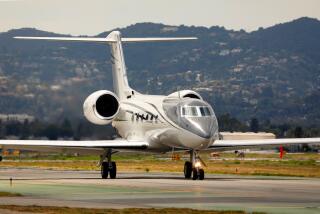Thanks to Leasing Agents, Airline May Be Flying Someone Else’s Planes
- Share via
NEW YORK — There’s a good chance that the plane you took on your last flight doesn’t belong to the airline whose brightly colored logo adorns the fuselage.
In one of every two cases, the the airline leases the plane from a specialized company or a bank. Aircraft leasing has taken off in a big way in the past few years, propelled by the tough economics of airline competition, the aging of the nation’s fleet, tax changes and other factors.
Almost half of the 2,700 jets operated by U.S. commercial airlines are leased rather than owned, compared with only 30% in 1983, according to industry estimates. Much of that growth has come in the last two or three years.
“There’s no real reason that an airline would want to own an aircraft right now,” said David Butterworth, a financial analyst for Wedbush Securities Inc. in Los Angeles. “Airlines want the flexibility (of leasing) and are willing to pay for it.”
Jet aircraft don’t come cheap. A commercial liner made by Boeing Co., McDonnell Douglas Corp. or Lockheed Corp. costs anywhere from $25 million to $100 million. Big airlines buffeted by the head winds of competition and squeezed by high labor and advertising costs may well balk at the investment.
There are plenty of reasons, on the other hand, for carriers to lease planes.
The competition sparked by the deregulation of the U.S. airline industry in 1978 means that carriers have to move nimbly to establish new hubs, shift their routes and make other changes requiring new aircraft.
But the big aircraft manufacturers have a much longer time horizon--they need many months to design and build new models and produce existing ones.
That’s where the leasing companies come in. They fill the gap between the slow-moving aircraft makers and the pressed airlines by buying up batches of different kinds of planes and leasing them to carriers in a pinch.
“We’re offering airlines flexibility,” said Steven Udvar-Hazy, president of International Lease Finance Corp., a major aircraft leasing company based in Beverly Hills.
Tax changes also have played a role. As part of the mammoth federal tax reform of 1986, the investment tax credit was eliminated for most aircraft purchases, removing an incentive for many airlines to own a jet.
And the recent sprouting of scores of new, smaller airlines in Western Europe with flashy names like Air 2000 and Hispania has created a new market for jet lessors around the world.
Leasing companies have been quick to capitalize on the airlines’ hunger for “short-order” planes.
International Lease Finance is widely considered the most aggressive of the aircraft lessors. It boasts a “jet portfolio” of about 60 aircraft worth $2 billion, with another 197 on order. Among its 70 customers are several major U.S. airlines as well as foreign carriers, including British Airways, Lufthansa of West Germany, Scandinavian Airlines System, Singapore Airlines, Garuda Indonesia and Varig of Brazil.
Another big U.S. lessor is San Francisco-based GATX Air, a subsidiary of financial services company GATX Corp.
In Europe, the industry leader is GPA Group Ltd., one of the largest companies in Ireland, which describes itself as a sort of “investment banker” for the aviation industry.
Ansett Transport Industries Ltd., a huge Australian company that is half-owned by media tycoon Rupert Murdoch, owns eight airlines and has an active jet-leasing subsidiary.
These companies specialize in short-term “operating leases” running for an average three to seven years, after which the aircraft are returned to the lessors.
Major banks and companies like GE Capital (a subsidiary of General Electric Co.) deal mainly in longer-term “capital leases” that work like installment plans. Airlines often end up owning the planes at the end of the capital lease period.
Leasing costs vary widely, depending on the age and condition of the aircraft, how desirable the model is at the time the contract is signed, and other factors. A $100-million Boeing 747 jumbo jet, for example, would cost roughly $12 million to $15 million a year to lease.
The airlines’ need for new planes has been intensified recently by the aging of the nation’s commercial fleet--caused largely by lower fuel prices that allowed the carriers to postpone purchases of more fuel-efficient aircraft.
The average age of U.S. jetliners is 12.53 years, up 21% since 1979. More than half the jets operated by major carriers are 16 years old or older, according to Avmark Inc., an aviation consulting firm in Arlington, Va.
More to Read
Inside the business of entertainment
The Wide Shot brings you news, analysis and insights on everything from streaming wars to production — and what it all means for the future.
You may occasionally receive promotional content from the Los Angeles Times.










